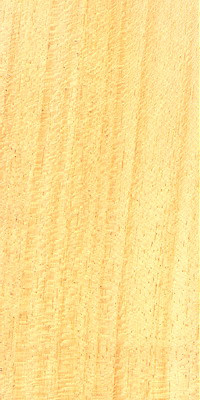

Ayous is the pilot name of a tropical tree native to West and Central Africa, also commonly known as obeche, abachi, samba or wawa. This exotic timber has long been one of the most exploited species in this region. Ayous timber offers a bright, creamy white to light yellow appearance, and thus has aesthetic potential for interior design. Ayous timber is used in the ceilings of the Paris-Charles de Gaulle airport.

Triplochiton scleroxylon K. Schum
Family: Malvaceae (Sterculiaceae)
Commercial restrictions: no commercial restriction
Ayous, also often called obeche, abachi, wawa, bado or samba, dominates the semi-deciduous tropical forests of West and Central Africa from the top of its 50 meters. The diameter of the barrel is usually around 150 cm, but can reach 2 meters. The bole is straight but rarely cylindrical, and is free of branches up to 30 meters. Thin winged buttresses develop around the bole up to 6/8 meters high.
The bark of this tropical tree is gray to yellow-brown, smooth in young individuals and then rough and scaly. The leaves looks like maple’s leaves and are used in cooking in Côte d'Ivoire and Benin, and the brown flowers are very fragrant.
Suppliers: Ayous suppliers
Ayous is a very light, exotic wood, very tender to tender. The timber is light yellow, sometimes even creamy white.
It is necessary to treat it at all stages of processing because it is not resistant to rot, termites or lyctus, although it is not very impregnable.
Ayous timber is used for interior joinery, for moulding, as well as for boxes and plywood. Its impregnability makes it suitable for the interior fittings of part of the Roissy-Charles de Gaulle airport: ayous, used in the form of ceiling strips, covers the ceilings and part of the vertical walls of the main hall of terminal 2E.
Ayous is a species native to West and Central Africa: it is distributed in Sierra Leone, Liberia, Ivory Coast, Ghana, Togo, Benin, Nigeria, Cameroon, Guinea, Gabon, Central African Republic, Congo and the Democratic Republic of Congo.
The climate of the Ayous distribution area is characterized by constant temperatures of 25-30° C, a low thermal range and constant humidity with an average monthly rainfall of 200 mm.
Ayous grows in dense forests at low and medium altitudes. It adapts to many types of soils, with a preference for well-drained ferruginous and clayey soils.
The fruit-forming is rather irregular but vegetative propagation helps to overcome this irregularity. Taking cutting gives better results than layering.
Ayous loses all its leaves for 2 weeks to a month at the peak of the dry season.
Pollination is mainly done by insects. The seeds are then dispersed by the wind over distances of 100 to 150 meters.
Download the Tropix sheet (CIRAD).
Download the Tropix sheet (CIRAD).
Download the Tropix sheet (CIRAD).
Sources: CIRAD - ATIBT
Copyright photo: Q. Meunier, C. Moumbogou, J.-L. Doucet, 2015. Les arbres utiles du Gabon
use(s) for this species :